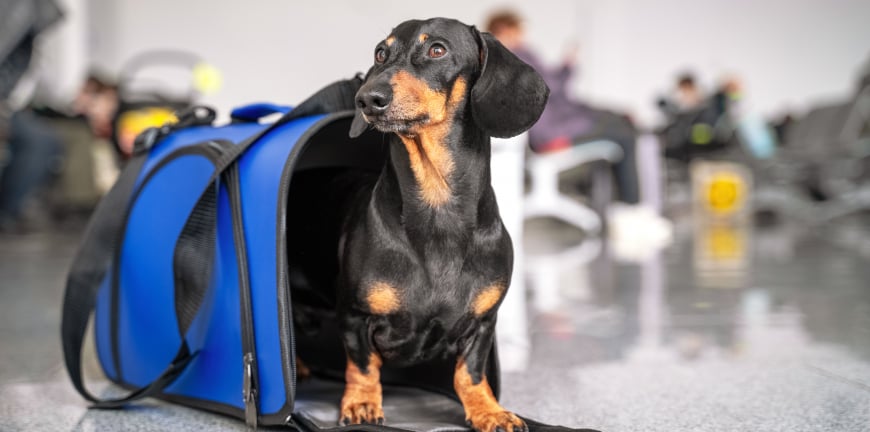July 21, 2024

Which international airlines allow pets in cabins?
Which international airlines allow pets in cabins?
Does the thought of putting your fur baby in the cargo hold fill you with dread?
Many pet owners were happy to hear the welcome news that Virgin Australia will accept pets in the cabin on domestic flights, although there are still restrictions in place depending on the size and type of pet. There are some international airlines that allow pets to travel in the cabin, although policies and restrictions may vary. Remember that destination restrictions exist for certain countries. For example, if the destination country has strict animal importation rules in place, such as the UK or Australia, this will impact whether your pet is permitted in the cabin on the airline.
Also, it is necessary to book the flight directly with the airline that allows pets in the cabin, and make sure it is not a codeshare flight with another airline, as this can also impact whether your pet is able to travel with you in the cabin.
If you are travelling from Australia to Europe, for instance, you would need to fly your pet in the hold to Singapore or Tokyo, and then fly the pet the rest of the way in the cabin with one of the airlines below. Remember policies on pets are constantly updated, so it is always best to contact the airline directly.
Here are some major international airlines that typically permit pets in the cabin.
Air France
Air France permits the in-cabin travel of both cats and small dogs but enforces a weight limit, including the carrier bag. It’s important to note that crates are not permitted in the cabin, so ensure that the carrier bag purchased complies with the airline’s regulations. Certain dog breeds such as Staffordshire Terriers, American Staffordshire Terriers (pit bulls), Mastiffs, and Tosas are not allowed. Although Air France operates internationally, pets are not allowed in the business cabin on intercontinental flights.
If your cat or dog weighs between 8kg / 17.64 lb. and 75 kg / 165.35 lb. with its kennel, it must travel in the hold. Since travelling with dogs or cats in the hold can be limited or prohibited on certain types of aircraft, you must submit a request at least 48 hours before your departure.
One passenger may only travel with a maximum of 3 animals in the hold – this number may be limited depending on the plane type. For more information visit the Air France website or if you are in Australia call the reservation centre on 02 933 82260.
Alaska Air
Dogs and cats are the only permitted animals to travel in the cabin to Hawaii and certain international locations. Find out more by visiting their website.
Lufthansa
On Lufthansa, animals can be transported either in the cabin or in the cargo hold: A maximum of two animals (either dogs or cats) in the cabin, each in an approved transport container, or a maximum of two animals in the cargo hold, accommodated in one or two approved transport containers. You can find out more about pets as carry on baggage with Lufthansa by visiting their website.
Singapore Airlines
Singapore Airlines allows passengers to bring small pets into the cabin, with specific regulations in place. Only dogs and cats are permitted, and they must be a minimum of 16 weeks old. The total weight of the pet and carrier must not surpass 7kg (15lbs). Remember you need to organise all the necessary paperwork prior to your departure. Read more on their website.
KLM Royal Dutch Airlines
When flying Economy Class or Business Class within Europe, you’re permitted to bring one cat or dog into the cabin. Your pet must be able to fit into a closed pet travel bag or kennel with dimensions not exceeding 46 x 28 x 24 cm, as they will need to be stowed under the seat in front of you.
Turkish Airlines
Cats, dogs, and small songbirds (parakeets, canaries) are the only types of pets permitted in the aircraft cabin. Pets travelling in the aircraft cabin, along with their carrier, must not surpass a combined weight of 8 kg. The carrier’s dimensions must not exceed 23 cm in height, 30 cm in width, and 40 cm in length. For pets traveling in the aircraft cargo hold, carriers or cages must not exceed 75 cm in height, 75 cm in width, and 125 cm in length. Read more about pets travelling in the cabin with Turkish Airlines.
United Airlines
In-cabin pet travel is limited to cats and dogs, contingent upon availability of space. Each passenger is allowed to travel with a maximum of two pets. When traveling with two pets, two seats must be purchased on the flight, with the second seat positioned adjacent to the assigned seat to ensure proper care for both pets. These guidelines apply regardless of the type of furry companion you have.
More airlines from the USA which allow pets in the cabin:
- American Airlines
- Delta Airlines
- Frontier Airlines
Final thought
As policies and regulations may change, it’s essential to verify the current requirements with the specific airline you plan to fly with and make arrangements for pet travel well in advance. Additionally, some airlines may have restrictions on the number of pets allowed in the cabin per flight, so it’s advisable to book early.
*Please note that most airlines that say they allow pets in the cabin do so mostly on domestic flights – not on international flights (except for service dogs). At the time of writing, the above airlines allow pets in the cabin but always check with the airline first.